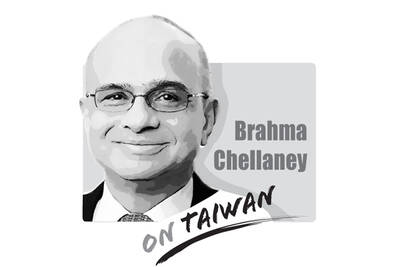In the past, if mainstream media did not cover certain incidents, nobody would have known about it. Today, the Wild Strawberry Student Movement has made use of the Internet to link up protesters across the country and created a new force. Nevertheless, the students would be well advised to consider how they could improve their movement.
Traditional media outlets have argued that the Wild Strawberry Student Movement would be difficult to maintain because President Ma Ying-jeou (馬英九) and Premier Liu Chao-shiuan (劉兆玄) have adopted a strategy of waiting until the demonstrators give up. This is why the student movement has encountered so many setbacks. Distorted and slanderous media coverage of the movement has given rise to biased public opinion toward the group.
The demonstrators should not give up, because their live Internet TV reports highlighted certain problems with traditional media. In particular, the shallow media coverage of the movement failed to clearly represent the three major appeals of the students, which in turn led to a discrepancy between public perception of the movement and reality. That is to say, the public should compare Internet reports with media coverage and form their own opinion based on what they find reliable and believable.
Nobody expected much from a civil movement like the Wild Strawberry movement in the beginning. If professors or experienced student movement activists could have helped design issues to attract public attention and if the students had aggressively created issues using blogs, Internet forums, stickers, Web sites and the Google community, the movement would have been more successful.
I have been a journalist for decades and I have to say that while news tools are constantly changing and becoming more diversified, the primary goal of news should be to remain truthful and get the facts right.
Many students may have had little, if any, experience dealing with the media, but they need not worry, because they have access to tools such as BBS, Twitter, Facebook and YouTube. These may seem like small, insignificant things, but these tools can be used as platforms to reach every corner of society. The weeks-long sit-has gained wide recognition both in Taiwan and abroad. This shows how influential new media tools have become.
There are also many examples of smaller groups fighting against larger forces. For example, in February, 4 million Colombians dressed in white T-shirts hit the streets in protest against kidnappings carried out by Colombia’s left-wing guerrilla group Revolutionary Armed Forces of Colombia (FARC). This protest was planned and mobilized using Facebook. Another example came in March, when a group of bloggers in Taiwan conducted an online fundraising campaign to help save the Losheng Sanatorium from being demolished to make room for a Mass Rapid Transport depot. This group managed to raise NT$200,000 in a single day. The bloggers then placed advertisements in newspapers and called a large protest to save Losheng.
These actions turned the Losheng Sanatorium into a topic for the Democratic Progressive Party in the preliminary presidential debates and forced the government to slow down its plans to demolish it.
These examples show that with perseverance on issues that matter, it is possible to change things. This power can ultimately be used to improve our country.
Let us hope that each member of the Wild Strawberry Student Movement can continue to fight for his or her beliefs.
Lu I-ming is the former publisher and president of the Taiwan Shin Sheng Daily News.
TRANSLATED BY TED YANG AND DREW CAMERON
US President Donald Trump created some consternation in Taiwan last week when he told a news conference that a successful trade deal with China would help with “unification.” Although the People’s Republic of China has never ruled Taiwan, Trump’s language struck a raw nerve in Taiwan given his open siding with Russian President Vladimir Putin’s aggression seeking to “reunify” Ukraine and Russia. On earlier occasions, Trump has criticized Taiwan for “stealing” the US’ chip industry and for relying too much on the US for defense, ominously presaging a weakening of US support for Taiwan. However, further examination of Trump’s remarks in

As strategic tensions escalate across the vast Indo-Pacific region, Taiwan has emerged as more than a potential flashpoint. It is the fulcrum upon which the credibility of the evolving American-led strategy of integrated deterrence now rests. How the US and regional powers like Japan respond to Taiwan’s defense, and how credible the deterrent against Chinese aggression proves to be, will profoundly shape the Indo-Pacific security architecture for years to come. A successful defense of Taiwan through strengthened deterrence in the Indo-Pacific would enhance the credibility of the US-led alliance system and underpin America’s global preeminence, while a failure of integrated deterrence would
It is being said every second day: The ongoing recall campaign in Taiwan — where citizens are trying to collect enough signatures to trigger re-elections for a number of Chinese Nationalist Party (KMT) legislators — is orchestrated by the Democratic Progressive Party (DPP), or even President William Lai (賴清德) himself. The KMT makes the claim, and foreign media and analysts repeat it. However, they never show any proof — because there is not any. It is alarming how easily academics, journalists and experts toss around claims that amount to accusing a democratic government of conspiracy — without a shred of evidence. These
China on May 23, 1951, imposed the so-called “17-Point Agreement” to formally annex Tibet. In March, China in its 18th White Paper misleadingly said it laid “firm foundations for the region’s human rights cause.” The agreement is invalid in international law, because it was signed under threat. Ngapo Ngawang Jigme, head of the Tibetan delegation sent to China for peace negotiations, was not authorized to sign the agreement on behalf of the Tibetan government and the delegation was made to sign it under duress. After seven decades, Tibet remains intact and there is global outpouring of sympathy for Tibetans. This realization